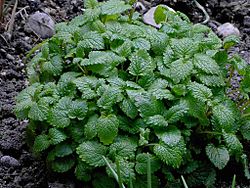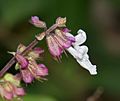Lamiaceae facts for kids
Quick facts for kids Mint family |
|
|---|---|
 |
|
| Lemon balm (Melissa officinalis) | |
| Scientific classification | |
| Kingdom: | |
| Division: | |
| Class: | |
| Order: | |
| Family: |
Lamiaceae
|
| Genera | |
|
See text |
|
The Lamiaceae family, also known as the mint family, is a large group of plants. It includes about 210 different types of genera (groups of similar plants) and around 3,500 species (individual kinds of plants).
Many plants in the mint family have a strong, pleasant smell. This is why they are often called aromatic. You might know many of them as cooking herbs! Some popular examples include basil, mint, rosemary, sage, savory, marjoram, oregano, hyssop, thyme, lavender, and perilla.
While many mint family plants are small herbs, some can be shrubs or even trees, like teak. A few are also vines. People love to grow these plants because they are often easy to care for. You can even grow new plants from a small piece of a stem!
Besides their tasty leaves, some plants in this family are grown for their beautiful leaves, like Coleus. Others are grown for their seeds, such as Salvia hispanica (which gives us chia seeds). Some even have edible roots or tubers, like the Plectranthus esculentus or Stachys affinis (Chinese artichoke).
Discovering the Mint Family's Plants
The mint family is huge, with many different kinds of plants. Scientists group these plants into different genera. Each genus contains species that are closely related. Here are just a few examples of the many interesting genera found in the Lamiaceae family:
- Ajuga: Also known as bugleweed, these plants often have attractive foliage and small flowers.
- Coleus: Famous for its brightly colored leaves, often grown as an ornamental plant.
- Dracocephalum: Known as dragonhead, some species are used in traditional medicine.
- Glechoma: Includes ground ivy, a common creeping plant.
- Hyssopus: The hyssop plant, used as a culinary herb and in perfumes.
- Lamium: Includes deadnettles, which look a bit like stinging nettles but don't sting.
- Lavandula: Lavender, famous for its calming scent and beautiful purple flowers.
- Leonotis: Known as lion's ear or wild dagga, with unique orange flowers.
- Marrubium: Horehound, a plant traditionally used in cough drops.
- Melissa: Lemon balm, a herb with a fresh, lemony scent.
- Mentha: This is the true mint genus, including peppermint and spearmint.
- Monarda: Bee balm or bergamot, known for attracting pollinators.
- Nepeta: Includes catnip, a plant that many cats love!
- Ocimum: The genus for basil, a very popular cooking herb.
- Origanum: Oregano and marjoram belong to this genus.
- Perilla: Used in Asian cuisine and as an ornamental plant.
- Phlomis: Known as Jerusalem sage, with interesting flower spikes.
- Plectranthus: A diverse group, including some edible root crops.
- Prunella: Self-heal, a common wildflower.
- Rosmarinus: Rosemary, a woody herb with needle-like leaves.
- Salvia: A very large genus that includes sage and many beautiful flowering plants.
- Scutellaria: Skullcaps, often used in herbal remedies.
- Stachys: Includes lamb's ear, known for its soft, fuzzy leaves, and Chinese artichoke.
- Teucrium: Germanders, often grown as garden plants.
- Thymus: Thyme, another widely used culinary herb.
- Vitex: Includes the chaste tree, which can grow quite large.
Images for kids
-
Leucas aspera in Hyderabad, India.
-
Oregano (Origanum vulgare)
See also
 In Spanish: Lamiaceae para niños
In Spanish: Lamiaceae para niños







